World War II

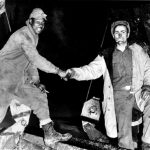 For as long as I can remember, the Alaskan Highway, known as the ALCAN Highway, has been something my parents, and especially my dad had been interested in…for most of his adult life, in fact. Construction began on the highway during World War II for the purpose of connecting the contiguous United States to Alaska through Canada. The highway begins in Dawson Creek, British Columbia, at the junction of several Canadian highways, and runs to Delta Junction, Alaska, via Whitehorse, Yukon. The highway was completed in 1942 at a length of 1,700 miles, but as of 2012, it is only 1,387 miles long. The difference is due to constant reconstruction of the highway, which has included rerouting and straightening numerous sections. The highway formally opened on November 21, 1942, but only for military use. It was not opened to the public until 1948. The highway has been legendary for decades as being a rough and challenging drive, probably because parts of it were not paved. Now however, the entire length is paved, so I suppose that took much of the difficulty out of it.
For as long as I can remember, the Alaskan Highway, known as the ALCAN Highway, has been something my parents, and especially my dad had been interested in…for most of his adult life, in fact. Construction began on the highway during World War II for the purpose of connecting the contiguous United States to Alaska through Canada. The highway begins in Dawson Creek, British Columbia, at the junction of several Canadian highways, and runs to Delta Junction, Alaska, via Whitehorse, Yukon. The highway was completed in 1942 at a length of 1,700 miles, but as of 2012, it is only 1,387 miles long. The difference is due to constant reconstruction of the highway, which has included rerouting and straightening numerous sections. The highway formally opened on November 21, 1942, but only for military use. It was not opened to the public until 1948. The highway has been legendary for decades as being a rough and challenging drive, probably because parts of it were not paved. Now however, the entire length is paved, so I suppose that took much of the difficulty out of it.
My dad has always loved to travel, and the ALCAN Highway literally called his name. It was his dream for all of his daughters and their families to caravan to Alaska by way of the ALCAN Highway. I think that needed to be a trip taken when we were all still single, and living at home, because it ended up being an unrealized dream 
 from my dad’s life. I think Dad would have made the trip anytime we could all get our plans together, but that simply never happened. If one of us could have done it, some of the others couldn’t have, and Dad couldn’t fathom the idea of leaving anyone out. When their 50th wedding anniversary rolled around in 2003, my sisters and I decided that we needed to send them on an Alaska cruise, and while it was not the drive on the ALCAN Highway that Dad had wanted, it did let them visit Alaska, and that was the main thing…I suppose. They had a wonderful time, but I’m sure that it was a little bittersweet too, because they were there without their family. My husband, Bob and I, and my niece Toni Chase and her husband, Dave have since taken cruises to Alaska too, and I know my parents would be happy about that, but looking back now, I wish we could have figured out a way to make their dream of the drive on the ALCAN Highway a reality. I really do continue to regret that.
from my dad’s life. I think Dad would have made the trip anytime we could all get our plans together, but that simply never happened. If one of us could have done it, some of the others couldn’t have, and Dad couldn’t fathom the idea of leaving anyone out. When their 50th wedding anniversary rolled around in 2003, my sisters and I decided that we needed to send them on an Alaska cruise, and while it was not the drive on the ALCAN Highway that Dad had wanted, it did let them visit Alaska, and that was the main thing…I suppose. They had a wonderful time, but I’m sure that it was a little bittersweet too, because they were there without their family. My husband, Bob and I, and my niece Toni Chase and her husband, Dave have since taken cruises to Alaska too, and I know my parents would be happy about that, but looking back now, I wish we could have figured out a way to make their dream of the drive on the ALCAN Highway a reality. I really do continue to regret that.
Over the years, informal historic mileposts have been added to denote major stopping points in the highway’s construction. Dawson Creek sports the milepost marker for the start of the ALCAN Highway. Delta Junction, which is the end of the highway, makes reference to its location at Historic Milepost 1422. The Alaska Highway meets the Richardson Highway at this point. The Richardson Highway continues 96 miles to the city of 
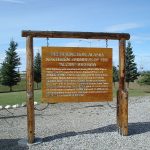 Fairbanks. This is often regarded, though unofficially, as the northern portion of the Alaska Highway, with Fairbanks at Historic Milepost 1520. It makes sense, but was not part of the original construction. The mileposts on this stretch of highway are measured from Valdez, rather than the Alaska Highway. Another oddity is that, the ALCAN Highway is popularly, though not officially, considered part of the Pan-American Highway, which extends south to Argentina, despite its discontinuity in Panama. It’s quite an amazing system, and I think I can see why my dad was so fascinated by it.
Fairbanks. This is often regarded, though unofficially, as the northern portion of the Alaska Highway, with Fairbanks at Historic Milepost 1520. It makes sense, but was not part of the original construction. The mileposts on this stretch of highway are measured from Valdez, rather than the Alaska Highway. Another oddity is that, the ALCAN Highway is popularly, though not officially, considered part of the Pan-American Highway, which extends south to Argentina, despite its discontinuity in Panama. It’s quite an amazing system, and I think I can see why my dad was so fascinated by it.
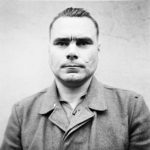
 I have always been somewhat amazed that, after a war is over, it seems that there must follow a trial for war crimes. It isn’t so much the trial, the obvious crimes against humanity that are always a part of war, or even the outrage over it all, that most amazes me, but rather the fact that even in war, people are expected to follow certain standards, or rules of engagement. I think that there are evil people on either side of a war, but some wars seem to have more evil involved than others…or maybe we were just more appalled in earlier wars. I think that is a possibility, because we have all become less shocked by the heinous acts people are able to perform. Still, I am completely shocked that they can stomach such things without becoming violently ill.
I have always been somewhat amazed that, after a war is over, it seems that there must follow a trial for war crimes. It isn’t so much the trial, the obvious crimes against humanity that are always a part of war, or even the outrage over it all, that most amazes me, but rather the fact that even in war, people are expected to follow certain standards, or rules of engagement. I think that there are evil people on either side of a war, but some wars seem to have more evil involved than others…or maybe we were just more appalled in earlier wars. I think that is a possibility, because we have all become less shocked by the heinous acts people are able to perform. Still, I am completely shocked that they can stomach such things without becoming violently ill.
The horrible crimes committed against the Jews and the Gypsies prior to and during World War II, were crimes 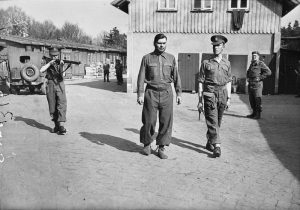 that the Allies simply could not overlook. The Belsen trial was one of several trials the Allied occupation forces held against former officials of Nazi Germany after the end of the war. The Belsen trial took place in Lüneburg, Lower Saxony, Germany in 1945. The defendants were men and women of the SS as well as prisoner officials who had worked at various concentration camps, notably Auschwitz and Bergen-Belsen. People around the world were interested in these trials, and as the public heard for the first time from some of those responsible for the mass murder in the eastern extermination camps, they were filled with contempt. Some later trials are also referred to as Belsen trials, a name that became synonymous with war crime trails of World War II.
that the Allies simply could not overlook. The Belsen trial was one of several trials the Allied occupation forces held against former officials of Nazi Germany after the end of the war. The Belsen trial took place in Lüneburg, Lower Saxony, Germany in 1945. The defendants were men and women of the SS as well as prisoner officials who had worked at various concentration camps, notably Auschwitz and Bergen-Belsen. People around the world were interested in these trials, and as the public heard for the first time from some of those responsible for the mass murder in the eastern extermination camps, they were filled with contempt. Some later trials are also referred to as Belsen trials, a name that became synonymous with war crime trails of World War II.
When the trials ended, and those who chose to commit such horrible acts as the Holocaust, Porajmos, and other war related crimes were found guilty, it was time for the next step in the justice process…carrying out the 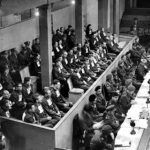
 sentencing. A report was made on November 18, 1945, regarding the completion of the Belsen Trial the day before, and the final outcome of said trial. Then, on December 13, 1945, Joseph Kramer and Irma Grese, the monarchs of Belsen were two of the people hanged for Nazi concentration camp crimes, according to the sentences imposed on them after the trial. Nine other concentration staff members were also hanged on the same day. Sentencing and the carrying out of said sentence was certainly handled more quickly than they would have been in this day and age.
sentencing. A report was made on November 18, 1945, regarding the completion of the Belsen Trial the day before, and the final outcome of said trial. Then, on December 13, 1945, Joseph Kramer and Irma Grese, the monarchs of Belsen were two of the people hanged for Nazi concentration camp crimes, according to the sentences imposed on them after the trial. Nine other concentration staff members were also hanged on the same day. Sentencing and the carrying out of said sentence was certainly handled more quickly than they would have been in this day and age.

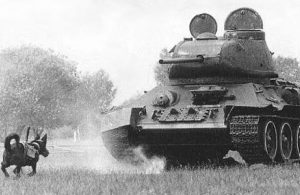 Over the years, people have trained dogs to perform many tasks that were too dangerous for their human counterparts…knowing that the very act of doing their duty would likely cost the dog its life. I think many of us would be sickened by the things these loyal animals went through, but I suppose that in the eyes of their trainers, they were heroes. During World War II, Joseph Stalin approved the use of “canine killers” to fight against German tanks. I think that in most ground wars, the tank is probably the most dreaded weapon there is. In many ways, it is like fighting a robot…it’s almost impossible to kill. The tanks could go right into the middle of the battle, and in fact, right over the people in front of them. They could also shoot from a distance. They were a major weapon against the ground troops. Stalin wanted a weapon to use against them, and decided that the dogs were just the right weapon.
Over the years, people have trained dogs to perform many tasks that were too dangerous for their human counterparts…knowing that the very act of doing their duty would likely cost the dog its life. I think many of us would be sickened by the things these loyal animals went through, but I suppose that in the eyes of their trainers, they were heroes. During World War II, Joseph Stalin approved the use of “canine killers” to fight against German tanks. I think that in most ground wars, the tank is probably the most dreaded weapon there is. In many ways, it is like fighting a robot…it’s almost impossible to kill. The tanks could go right into the middle of the battle, and in fact, right over the people in front of them. They could also shoot from a distance. They were a major weapon against the ground troops. Stalin wanted a weapon to use against them, and decided that the dogs were just the right weapon.
The dogs, usually Alsatians, called “Hundminen” or “dog mines” were trained by the Russians to run under German tanks, at which point the bomb strapped to their backs would explode, destroying the tank…and the dog too, of course. The dogs were going to be their secret weapon, but there was just one problem, at least with the first batch of Kamikaze Dog trainees. The dogs had been trained with Soviet tanks, not German ones. Soviet and German tanks used different types of fuel, and some of the dogs sniffed out the fuel they were used to and trotted off to blow up the tanks used by the very military that trained them. I’m sure that must have been quite a shock to their trainers. The dogs were initially trained to transport explosives to tanks, armored vehicles and other various targets, and then retreat before the bomb exploded, but when that didn’t work well, the routine was replaced by impact detonation, which resulted in the dog’s death. The training began in 1930, and whether they were useful or not the dogs were used in battle. Kamikaze Dogs started to be used less and less from 1942 onwards, though there were Kamikaze Dogs that continued to be trained until 1996.
I find myself feeling horrified by the picture this practice paints. Dogs are usually very loyal, and all they want to do is please their master. They trust their master, or in this case, their trainer, only to be rewarded with 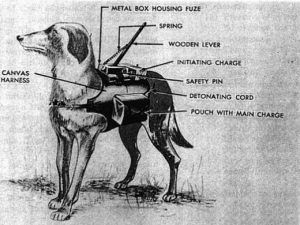
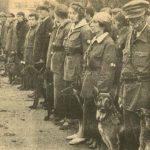 death. I’m sure that the Russians eventually got the dogs to the point where they recognized the right targets, or the practice wouldn’t have continued until about 1990. The Soviets have said that about 300 tanks had been destroyed by Kamikaze Dogs, but that number has been questioned by many. Most people think the number was probably made up by the Soviet government in an effort to justify the program, and particularly to justify killing so many dogs with so few results. What a horrible practice.
death. I’m sure that the Russians eventually got the dogs to the point where they recognized the right targets, or the practice wouldn’t have continued until about 1990. The Soviets have said that about 300 tanks had been destroyed by Kamikaze Dogs, but that number has been questioned by many. Most people think the number was probably made up by the Soviet government in an effort to justify the program, and particularly to justify killing so many dogs with so few results. What a horrible practice.
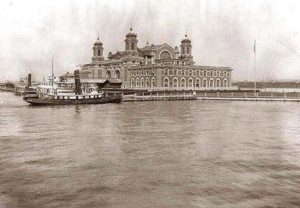 A number of my ancestors came to America during and prior to the years that Ellis Island was the processing center in New York. I have no doubt that some of them came through Ellis Island, but I have not confirmed that. I find many of the names in my tree, but while many of the ancestors I have found came over by way of New York, it would appear that my direct line arrived in America before the immigration center at Ellis Island opened on January 2, 1892. Before that time, immigrants were handled by the individual states where the immigrant first arrived. It is estimated that about 40% of Americans can trace their roots through Ellis Island, so while I see many familiar names, they may or may not be my direct line, and in fact, they might not be related at all.
A number of my ancestors came to America during and prior to the years that Ellis Island was the processing center in New York. I have no doubt that some of them came through Ellis Island, but I have not confirmed that. I find many of the names in my tree, but while many of the ancestors I have found came over by way of New York, it would appear that my direct line arrived in America before the immigration center at Ellis Island opened on January 2, 1892. Before that time, immigrants were handled by the individual states where the immigrant first arrived. It is estimated that about 40% of Americans can trace their roots through Ellis Island, so while I see many familiar names, they may or may not be my direct line, and in fact, they might not be related at all.
Ellis Island is located in New York Harbor off the New Jersey coast and was named for merchant Samuel Ellis, who owned the land in the 1770s. The island was given the nickname, The Gateway to America because more than 12 million immigrants passed through the center since it opened in 1892. On January 2, 1892, 15 year old Annie Moore, from Ireland, became the first person to pass through the newly opened Ellis Island, which President Benjamin Harrison designated as America’s first federal immigration center in 1890. Oddly, not all 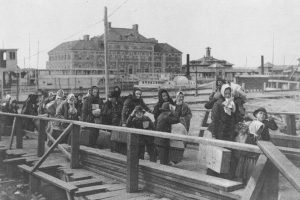 immigrants who sailed into New York had to go through Ellis Island. First and second class passengers were just given a brief shipboard inspection and then disembarked at the piers in New York or New Jersey, where they passed through customs. People in third class, though, were transported to Ellis Island, where they underwent medical and legal inspections to ensure they didn’t have a contagious disease or some condition that would make them a burden to the government. Nevertheless, only two percent of all immigrants were denied entrance into the United States. The peak years of immigration through Ellis Island were from 1892 to 1924. The 3.3 acre island was enlarged by landfill, and by the 1930s, it had reached its current size of 27.5 acres. After the extra size was completed, new buildings were constructed to handle the massive influx of people coming to America for a better life. During it’s busiest year, which was 1907, over 1 million people were processed through Ellis Island.
immigrants who sailed into New York had to go through Ellis Island. First and second class passengers were just given a brief shipboard inspection and then disembarked at the piers in New York or New Jersey, where they passed through customs. People in third class, though, were transported to Ellis Island, where they underwent medical and legal inspections to ensure they didn’t have a contagious disease or some condition that would make them a burden to the government. Nevertheless, only two percent of all immigrants were denied entrance into the United States. The peak years of immigration through Ellis Island were from 1892 to 1924. The 3.3 acre island was enlarged by landfill, and by the 1930s, it had reached its current size of 27.5 acres. After the extra size was completed, new buildings were constructed to handle the massive influx of people coming to America for a better life. During it’s busiest year, which was 1907, over 1 million people were processed through Ellis Island.
When the United States entered into World War I, immigration to the United States decline, most likely because travel anywhere was risky. Ellis Island was used as a detention center for suspected enemies during that time. Following the war, Congress passed quota laws and the Immigration Act of 1924, which sharply reduced the number of newcomers allowed into the country and also enabled immigrants to be processed at United States  consulates abroad. The act also enabled immigrants to be processed at United States consulates abroad, making detention at Ellis Island obsolete. After 1924, Ellis Island switched from a processing center to other purposes, such as a detention and deportation center for illegal immigrants, a hospital for wounded soldiers during World War II and a Coast Guard training center. In November 1954, the last detainee, a Norwegian merchant seaman, was released and Ellis Island officially closed on November 12, 1954. In 1984, Ellis Island underwent a $160 million renovation, the largest historic restoration project in United States history. In September 1990, the Ellis Island Immigration Museum opened to the public and is visited by almost 2 million people each year.
consulates abroad. The act also enabled immigrants to be processed at United States consulates abroad, making detention at Ellis Island obsolete. After 1924, Ellis Island switched from a processing center to other purposes, such as a detention and deportation center for illegal immigrants, a hospital for wounded soldiers during World War II and a Coast Guard training center. In November 1954, the last detainee, a Norwegian merchant seaman, was released and Ellis Island officially closed on November 12, 1954. In 1984, Ellis Island underwent a $160 million renovation, the largest historic restoration project in United States history. In September 1990, the Ellis Island Immigration Museum opened to the public and is visited by almost 2 million people each year.
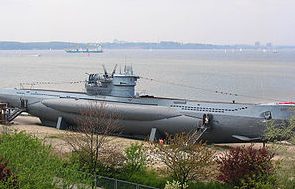 Anytime a soldier goes to war, there is a possibility of that soldier not returning, but some MOS (Military Occupational Specialty) categories were more dangerous than others. The life expectancy of a ball turret gunner in World War II, for instance, was just 12 minutes…yes, that’s right…12 minutes. And these guys didn’t always have a choice as to what job they did. If they were the shortest, they were most likely going to be a ball turret gunner, because of limited space in the ball. Still, while I don’t know the exact number who died, I know it was quite a few. Of course, soldiers on the ground are more at risk than other occupations too. There were the suicide bombers from Japan, who chose to fly their plane right into a ship too, but I think that few occupations were as deadly as that of the U-Boat crew. It wasn’t so much that the occupation was deadly, but rather that every country in the world was after the German U-Boat.
Anytime a soldier goes to war, there is a possibility of that soldier not returning, but some MOS (Military Occupational Specialty) categories were more dangerous than others. The life expectancy of a ball turret gunner in World War II, for instance, was just 12 minutes…yes, that’s right…12 minutes. And these guys didn’t always have a choice as to what job they did. If they were the shortest, they were most likely going to be a ball turret gunner, because of limited space in the ball. Still, while I don’t know the exact number who died, I know it was quite a few. Of course, soldiers on the ground are more at risk than other occupations too. There were the suicide bombers from Japan, who chose to fly their plane right into a ship too, but I think that few occupations were as deadly as that of the U-Boat crew. It wasn’t so much that the occupation was deadly, but rather that every country in the world was after the German U-Boat.
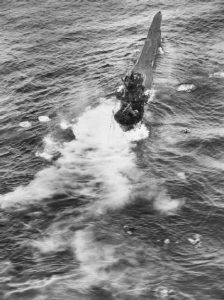
The U-Boat was a German submarine, and they were the best sumbarine the Germans had. There were 40,000 men who were assigned to the German U-Boats during World War II. Of those assigned to the U-Boats, only 10,000 returned. That is a shocking number!! I would never have wanted the Germans to win World War II, but when I think of the soldiers who fought, I’m sure that there were many who disagreed with Hitler, and others who were brainwashed into following him, but they were still soldiers, and people, and they had been given an assignment that was going to most likely get them killed. You see, the German U-Boat was the most feared of all the ships or submarines during World War II. They had a code system that was hard to crack, and they were sinking the Allies ships. They had to go. Once the Allies figured out their code, they could no longer hide. The U-Boats began dropping like flies, and with them…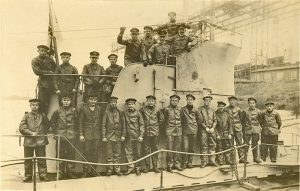 their crews, of course.
their crews, of course.
The U-Boats ran on battery power when they were submerged, and that didn’t last very long. So they were required to be a surface vessel most of the time, operating on their diesel engines. I don’t think that contributed to the U-Boat becoming a target, because as long as their whereabouts was coded, they were relatively safe. Once that safety net was gone, they were in a lot of trouble, as has been proven by the number of casualties. The fate of the crews of the U-Boats was not a good one, and those 30,000 men paid the final price, once that safety net was gone.
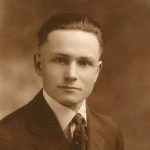
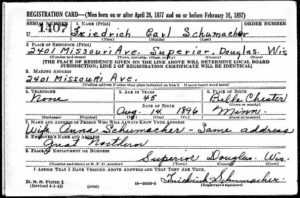 As I have researched my family history, I have come across a number of World War II draft registration cards for older men. I found that to be very strange. It seemed odd to me that men who were technically too old to serve in battle…at least by military standards, were required to register, and quite possibly be drafted into the war. Some of these men weren’t so very old by today’s standards, such as my great uncle, Friedrich Schumacher, who was 45 at the time of his World War II draft registration, or my grandfather, George Byer, who was 48 at the time of his World War II draft registration, but others, such as my grandfather, Allen Luther Spencer, who was 63 at the time of his World War II registration, were much older. These draft registrations really surprised me. Why would our government need to have these men register?
As I have researched my family history, I have come across a number of World War II draft registration cards for older men. I found that to be very strange. It seemed odd to me that men who were technically too old to serve in battle…at least by military standards, were required to register, and quite possibly be drafted into the war. Some of these men weren’t so very old by today’s standards, such as my great uncle, Friedrich Schumacher, who was 45 at the time of his World War II draft registration, or my grandfather, George Byer, who was 48 at the time of his World War II draft registration, but others, such as my grandfather, Allen Luther Spencer, who was 63 at the time of his World War II registration, were much older. These draft registrations really surprised me. Why would our government need to have these men register?
My curious mind had to know the answer to that question, and so I began to look online to see if anything was said about it at all. Well, it only took looking at three websites to find the answer. I wondered if they were just desperate for soldiers, because as most people know, World War II saw the most American war deaths at 405,399, than any other war in American history. Nevertheless, that was not the reason for the Fourth 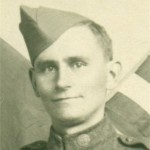
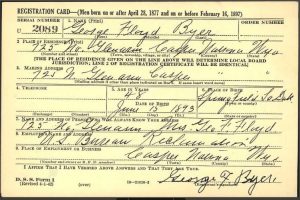 Registration, which became known as the Old Man’s Draft, because it targeted men between the ages of 45-64 years of age. No, these men were not going to be soldiers who were require to go into battle. This draft registration was intended to provide the government with a register of manpower…men who might be eligible for national service. Help was needed on the home front, and this was a way to ensure that the manpower needed was available. After all, if you are drafted, you are required to serve.
Registration, which became known as the Old Man’s Draft, because it targeted men between the ages of 45-64 years of age. No, these men were not going to be soldiers who were require to go into battle. This draft registration was intended to provide the government with a register of manpower…men who might be eligible for national service. Help was needed on the home front, and this was a way to ensure that the manpower needed was available. After all, if you are drafted, you are required to serve.
Registration of the Old Man’s Draft began on April 27, 1942 at local draft boards around the country, and like the patriotic citizens they were, my great uncle, and my grandfathers, along with many, many other older men, went to register. The lines were long when the men went in to register, according to the Poughkeepsie Journal, but the biggest regret that was heard among the men waiting there was…that they were too old to fight!! Seriously!! There were no complaints about standing for hours in line, or complaints about having to register at all…just that they would not see battle. These were not warmongers, but rather patriots who wanted to help in whatever way they could, and now Uncle Sam was telling them that their contribution was important. It felt 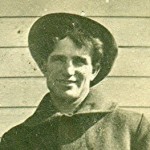
 amazing to these men. They were needed!! The biggest complication was that some of the men couldn’t read or write, and some had forgotten things like addresses, telephone numbers, or dates (including the year of birth, which is evident on my grandfather’s card in that his year of birth was listed as 1883, but he was born in 1879). Nevertheless, these men were hopeful that somehow they could be useful in the war effort. I find that completely amazing…especially in light of the lack of patriotism so often seen these days.
amazing to these men. They were needed!! The biggest complication was that some of the men couldn’t read or write, and some had forgotten things like addresses, telephone numbers, or dates (including the year of birth, which is evident on my grandfather’s card in that his year of birth was listed as 1883, but he was born in 1879). Nevertheless, these men were hopeful that somehow they could be useful in the war effort. I find that completely amazing…especially in light of the lack of patriotism so often seen these days.
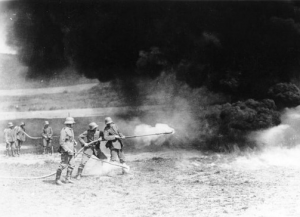 Over the centuries of life on Earth, there have been numerous wars, and numerous weapons of warfare. Yet, few could bring fear to the heart of an infantryman quicker than the Flammenwerfer. Developed by the Germans during World War I, the Flammenwerfer…or Flamethrower, in English…once lit could throw a steady stream of flames 20 to 30 feet in front of it. For the men on the ground, this meant one of two things. They could run…abandoning the relative safety of their foxhole, usually with the result of being shot down by the enemy, or they could stand their ground and be incinerated. It wasn’t much of a choice really, and most ran in the hope of escaping the machine gun fire that would undoubtedly follow the flamethrower. It was a situation of instant death…no matter which choice a soldier made…not to mention the fact that every fiber of a soldier’s being and training told them to stand their ground. This weapon took much of it toll on the soldier’s sense of bravery.
Over the centuries of life on Earth, there have been numerous wars, and numerous weapons of warfare. Yet, few could bring fear to the heart of an infantryman quicker than the Flammenwerfer. Developed by the Germans during World War I, the Flammenwerfer…or Flamethrower, in English…once lit could throw a steady stream of flames 20 to 30 feet in front of it. For the men on the ground, this meant one of two things. They could run…abandoning the relative safety of their foxhole, usually with the result of being shot down by the enemy, or they could stand their ground and be incinerated. It wasn’t much of a choice really, and most ran in the hope of escaping the machine gun fire that would undoubtedly follow the flamethrower. It was a situation of instant death…no matter which choice a soldier made…not to mention the fact that every fiber of a soldier’s being and training told them to stand their ground. This weapon took much of it toll on the soldier’s sense of bravery.
The Flammenwerfer was developed in 1915 by the Germans, and first used in battle against the Allied forces on this day, July 30, 1915 at the Battle of Hooge. Eleven days before that battle, British infantry had captured the German occupied village of Hooge, located near Ypres in Belgium, by detonating a large mine. Using the flamethrowers, along with machine guns, trench mortars and hand grenades, the Germans got their positions 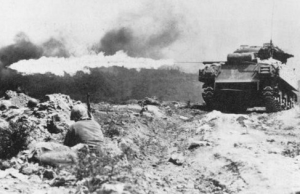 back on July 30, 1915. They broke through enemy front lines with ease, pushing the British forces back to their second trench. Only a few men were lost to actual burns, but a British officer was heard to explain that the weapons had a great demoralizing effect, and when added to the assault of the other powerful weapons, they proved mercilessly efficient at Hooge. I suppose that is true. I can think of few things more demoralizing for a soldier than running from your position in fear. Soldiers don’t take kindly to fear…or running away.
back on July 30, 1915. They broke through enemy front lines with ease, pushing the British forces back to their second trench. Only a few men were lost to actual burns, but a British officer was heard to explain that the weapons had a great demoralizing effect, and when added to the assault of the other powerful weapons, they proved mercilessly efficient at Hooge. I suppose that is true. I can think of few things more demoralizing for a soldier than running from your position in fear. Soldiers don’t take kindly to fear…or running away.
During World War I, the Germans were the only ones to use such a weapon, and not because it was difficult to make. So, why didn’t the Allies us it too? It was one of the great puzzles that emerged from World War I. Why? The British made three attempts with larger, more unwieldy prototypes: the smallest one was equal in size to the German Grof, which the enemy had almost abandoned by 1916. The French were more persistent, and by 1918 had at least seven companies trained in using flamethrowers, and still the use of the weapon never progressed to the same level as that of the German army.
By World War II, however, the flamethrower was the most dramatic hand weapon used by any Army and the most effective for its purpose. But it was during the 20th century that engineers and scientists placed flames 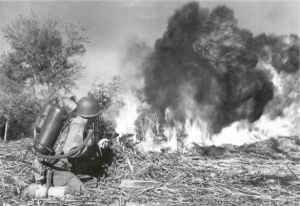 under advanced technological control in an effort to make flamethrowers portable, reliable and reasonably safe…for the user anyway. Prior to that the words “friendly fire” had a second meaning in that flamethrowers could kill the operator while he was doing his best to kill the enemy with it. The result of this new technology was a device with as much psychological impact as it’s lethality impact. That was the chief reason why the United States, Great Britain and other world powers used the flamethrower from World War I through the Vietnam War. Even today, Russia still has flamethrowers in its inventory. I guess it is an important weapon, but for most of us, I think that just the thought of using it on someone would make us seriously ill.
under advanced technological control in an effort to make flamethrowers portable, reliable and reasonably safe…for the user anyway. Prior to that the words “friendly fire” had a second meaning in that flamethrowers could kill the operator while he was doing his best to kill the enemy with it. The result of this new technology was a device with as much psychological impact as it’s lethality impact. That was the chief reason why the United States, Great Britain and other world powers used the flamethrower from World War I through the Vietnam War. Even today, Russia still has flamethrowers in its inventory. I guess it is an important weapon, but for most of us, I think that just the thought of using it on someone would make us seriously ill.
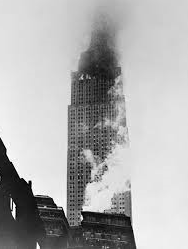
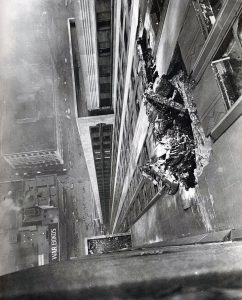 World War II saw the shooting down of more of our military planes that most of us want to think about. We saw the loss by planes being shot down, but also transport planes lost, and planes lost in training accidents. The loss was felt deeply. I realize that accidents are a fact of life and during wartime they are probably more likely to happen than other times, but some accidents just have a bigger impact on our emotions than others. Such was the case of the accident of July 28, 1945.
World War II saw the shooting down of more of our military planes that most of us want to think about. We saw the loss by planes being shot down, but also transport planes lost, and planes lost in training accidents. The loss was felt deeply. I realize that accidents are a fact of life and during wartime they are probably more likely to happen than other times, but some accidents just have a bigger impact on our emotions than others. Such was the case of the accident of July 28, 1945.
That morning, the skies over New York City were filled with heavy fog. A B-52 Mitchell Bomber with two pilots and one passenger aboard, en route from New Bedford, Massachusetts, to LaGuardia Airport in New York City, was diverted because the fog was so thick. As it came into the metropolitan area on that Saturday morning, air-traffic controllers instructed the plane to fly to Newark Airport instead.
The new flight plan took the plane over Manhattan. The pilots were warned that the Empire State Building, the tallest building in the city at that time, was not visible. In an effort to gain better visibility, the pilot of the bomber was flying relatively slowly and quite low. As the plane came in straight at the Chrysler Building in midtown, it swerved to avoid the collision, thereby setting it in a collision path with the Empire State Building, hitting the building near the 79th floor. The fuel tanks exploded, filling the building with flames down to the 75th floor, and out of the building at the impact site. One engine from the plane went straight through the building and landed in a penthouse apartment across the street. Other plane parts were embedded in and on top of nearby buildings. The other engine snapped an elevator cable while at least one woman was riding in the elevator car. The emergency auto brake saved the woman from crashing to the bottom, but the engine fell down the shaft and landed on top of it. Thankfully, the rescuers pulled the woman from the elevator, thereby saving her life.
July 28th was a Saturday that year, so there were fewer people in the building. The loss of life in the Empire State Building was only 11 people, but death came by way of horrific burns from the jet fuel, or being thrown from the building. The 11 people killed were all workers from the War Relief Services Department of the National Catholic Welfare Conference…the office that the plane crashed into on that fateful day. The other three deaths were the two pilots and their passenger. The crash left an 18 by 20 foot hole in the side of the Empire State Building. The building itself, stood however, because, this plane was nowhere near the size of the planes 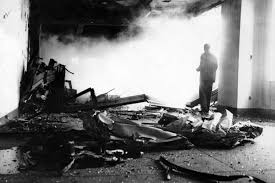
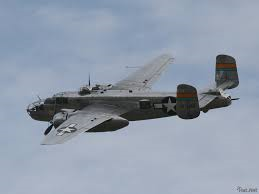 that took down the World Trade Center in Manhattan on Sept 11, 2001, an event that probably seemed eerily similar to those who were alive and living in New York City on July 28, 1945. The crash caused one million dollars in damage at that time, which would equate to about 10.5 million these days. For many people this was an event, much like 9-11 that would never be forgotten, even though it was not a terrorist attack, but rather a tragic accident.
that took down the World Trade Center in Manhattan on Sept 11, 2001, an event that probably seemed eerily similar to those who were alive and living in New York City on July 28, 1945. The crash caused one million dollars in damage at that time, which would equate to about 10.5 million these days. For many people this was an event, much like 9-11 that would never be forgotten, even though it was not a terrorist attack, but rather a tragic accident.
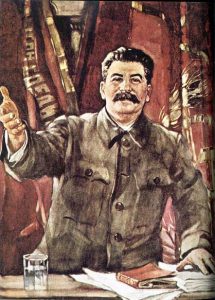 Imagine being in a country where being afraid is a crime. I’m sure you are wondering how that is possible…in any country, but I assure you, it is. That was the case on this day, July 27, 1943 in Russia. Joseph Stalin was the premier and dictator of Russia at that time in history, and Adolf Hitler was the dictator of Germany. The Germans were advancing into Russian territory, and Stalin was determined to stop them, no matter the cost.
Imagine being in a country where being afraid is a crime. I’m sure you are wondering how that is possible…in any country, but I assure you, it is. That was the case on this day, July 27, 1943 in Russia. Joseph Stalin was the premier and dictator of Russia at that time in history, and Adolf Hitler was the dictator of Germany. The Germans were advancing into Russian territory, and Stalin was determined to stop them, no matter the cost.
Hitler had become quite bold because of the early successes against Russia in his goal of taking Leningrad and Stalingrad. The attack on Stalingrad proved, however, that the Russians had superior manpower and it was an enormous drain on German resources and troop strength. The Germans were repulsed by a fierce Soviet fighting force, that had been reinforced with more men and materials. Hitler made the decision to turn his sights to Leningrad.
Stalin needed to make sure his force wouldn’t back down…no matter what happened. The motivation to stand 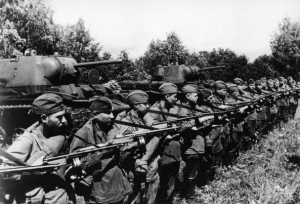 their ground needed to apply to both officers and civilians alike, or he was sure that Leningrad would be lost. That was when Stalin decided to put order number 227 into effect. So, what was order number 227? The order declared, “Panic makers and cowards must be liquidated on the spot. Not one step backward without orders from higher headquarters! Commanders…who abandon a position without an order from higher headquarters are traitors to the Fatherland.” Basically the order said that no one…not one person would be a coward. The order became known as the “not one step backward” order. The military personnel, as well as civilians were forced to fight for their city.
their ground needed to apply to both officers and civilians alike, or he was sure that Leningrad would be lost. That was when Stalin decided to put order number 227 into effect. So, what was order number 227? The order declared, “Panic makers and cowards must be liquidated on the spot. Not one step backward without orders from higher headquarters! Commanders…who abandon a position without an order from higher headquarters are traitors to the Fatherland.” Basically the order said that no one…not one person would be a coward. The order became known as the “not one step backward” order. The military personnel, as well as civilians were forced to fight for their city.
I think I can understand what Stalin was doing, but it seems such a drastic measure to take. Still, while some  people might fight the enemy to the end, others might decide that their city wasn’t worth their life. If the penalty for backing off was instant liquidation, then standing and fighting became the only way to have a chance at life. In my opinion, that as far as ways to gain loyalty goes, this was not the best of plans, but then forced loyalty seldom is. Still, one must never underestimate the love a patriot feels for their country. The “not one step backward” order was virtually unnecessary, in that on the day the order was issued, the Russian peasants and other supporters in the Leningrad region killed a German official, Adolf Beck, whose job was to send agricultural products from occupied Russia to Germany and to German troops. The Russian patriots also set fire to the granaries and barns in which the stash of agricultural products was stored before transport. A partisan pamphlet issued an order of its own: “Russians! Destroy the German landowners. Drive the Germans from the land of the Soviets!” I guess Stalin had misjudged his peoples’ loyalty.
people might fight the enemy to the end, others might decide that their city wasn’t worth their life. If the penalty for backing off was instant liquidation, then standing and fighting became the only way to have a chance at life. In my opinion, that as far as ways to gain loyalty goes, this was not the best of plans, but then forced loyalty seldom is. Still, one must never underestimate the love a patriot feels for their country. The “not one step backward” order was virtually unnecessary, in that on the day the order was issued, the Russian peasants and other supporters in the Leningrad region killed a German official, Adolf Beck, whose job was to send agricultural products from occupied Russia to Germany and to German troops. The Russian patriots also set fire to the granaries and barns in which the stash of agricultural products was stored before transport. A partisan pamphlet issued an order of its own: “Russians! Destroy the German landowners. Drive the Germans from the land of the Soviets!” I guess Stalin had misjudged his peoples’ loyalty.
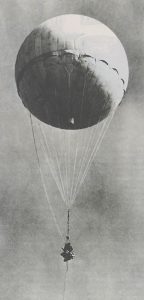 I suppose a true World War II history buff might know about some of the strange war stories there are out there, and I rather thought I was becoming a World War II history buff, but I had never heard of the Japanese Balloon Bombs. I can’t imagine how a nation could send a random bomb over another nation, not knowing where it will land, or who it will kill…but then, the evil we have seen in the 21st century has proven to be very much the same. I guess there really is nothing new under the sun. Where evil exists, horrible things happen. Such was the case with the Japanese Balloon Bombs. The Japanese were an evil nation at that time, and they didn’t care who they hurt. in 1945, a Japanese Balloon Bomb landed in rural Oregon, ad killed six people . As it turns out, these were the only World War II combat casualties within the continental 48 states. Apparently, the accuracy of the balloon bombs left something to be desired…thankfully.
I suppose a true World War II history buff might know about some of the strange war stories there are out there, and I rather thought I was becoming a World War II history buff, but I had never heard of the Japanese Balloon Bombs. I can’t imagine how a nation could send a random bomb over another nation, not knowing where it will land, or who it will kill…but then, the evil we have seen in the 21st century has proven to be very much the same. I guess there really is nothing new under the sun. Where evil exists, horrible things happen. Such was the case with the Japanese Balloon Bombs. The Japanese were an evil nation at that time, and they didn’t care who they hurt. in 1945, a Japanese Balloon Bomb landed in rural Oregon, ad killed six people . As it turns out, these were the only World War II combat casualties within the continental 48 states. Apparently, the accuracy of the balloon bombs left something to be desired…thankfully.
The idea of a balloon bomb was to send in a bomb that was silent. The problem is that balloons are hard to control. They go with the flow of the wind currents, so you don’t know where they will land. Then again, the Japanese were at war with the world, so they really didn’t care where the balloons would land. The six people who were killed by the Fu-Go or fire-balloon bomb, as they were called, were a Sunday School teacher Elyse Mitchell (and her unborn child), her 13 and 14 year old students, Jay Gifford, Edward Engen, Sherman Shoemaker, Dick Patzke, all of whom were killed instantly, when the bomb exploded. Dick Patzke’s sister, Joan was severely burned, and died moments later. The group had stopped for a moment, because Elyse Mitchell was feeling ill, and while her husband, Reverend Archie Mitchell talked with construction workers in the area, the six victims went to investigate a balloon they saw. It would prove to be a fatal mistake. The group had been going on a Saturday afternoon picnic near Klamath Falls, Oregon. They had only walked about 100 yards from the car. One of the road-crew workers, Richard Barnhouse, said “There was a terrible explosion. Twigs flew through the air, pine needles began to fall, dead branches and dust, and dead logs went up.”
Made of rubberized silk or paper, each balloon was about 33 feet in diameter. Barometer-operated valves released hydrogen if the balloon gained too much altitude or dropped sandbags if it flew too low. The balloons were filled with 19,000 cubic feet of hydrogen and the jet stream drew them eastward. They were designed to travel across the Pacific to North America, where they would drop incendiary devices or anti-personnel explosives. I would think the hydrogen alone would make a horrible bomb, but attached to the  balloon was the actual bomb. The Japanese released an estimated 9,000 fire balloons during the last months of World War II. At least 342 reached the United States, with some drifting as far as Nebraska. Some were shot down. Some caused minor damage when they landed, but no injuries. One hit a power line and blacked out the nuclear-weapons plant at Hanford, Washington. But the only known casualties from the 9,000 balloons…and the only combat deaths from any cause on the U S mainland were the five kids and their Sunday school teacher going to a picnic. What a valiant victory for the Japanese that was.
balloon was the actual bomb. The Japanese released an estimated 9,000 fire balloons during the last months of World War II. At least 342 reached the United States, with some drifting as far as Nebraska. Some were shot down. Some caused minor damage when they landed, but no injuries. One hit a power line and blacked out the nuclear-weapons plant at Hanford, Washington. But the only known casualties from the 9,000 balloons…and the only combat deaths from any cause on the U S mainland were the five kids and their Sunday school teacher going to a picnic. What a valiant victory for the Japanese that was.

